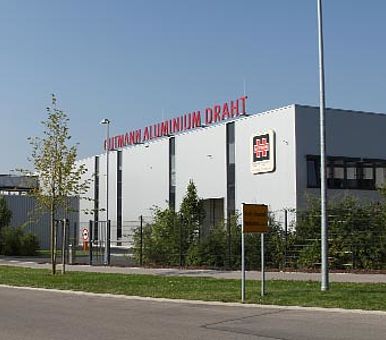Audit for ISO 9001:2015 & IATF 16949
News
GAD successfully passed the Management Systems Audit 2017. The innovative corporate culture plays an important role
Audit for ISO 9001:2015 & IATF 16949
Audit successfully completed
The ISO 9001:2015 and the more in-depth IATF 16949 have helped to establish a new concept of quality management in structures and processes. While the ISO 9001 generally stipulates the basic principles of management systems in companies and institutions, independently of sector, the IATF especially focuses on industrial processes – which are in turn derived from the automobile sector. The IATF is therefore a particularly important quality indicator for GUTMANN ALUMINIUM DRAHT, as a supplier for the automobile industry.

QMO as defined by ISO: from controller to navigator
To begin with, a few words on the general developments brought about by ISO 9001:2015: before the revision of the standard in 2015, the Quality Management Officer (QMO) was regarded as a hub for quality assurance, with the result that the other actors in a company tended to delegate challenges in this context to the QMO. Today, process risk assessment is required in all areas, and responsibility is more broadly distributed in a company. In the GAD system, this is reflected in the respectively defined areas of activity and responsibility. At the same time, there is a need for close coordination and cooperation with other areas of expertise and responsibility. This has also altered the job profile of the Quality Management Officer. At GAD, Stephan von Galkowski is responsible for the area of quality management. His job today is less that of a supervisor and implementer, and more that of a navigator and strategist to ensure that GAD continues to supply future-viable quality.
IATF: B-2-B customer safety and customer comfort are central
The IATF standards highlight B-2-B customer needs with regard to quality management and safety as a central aspect. The final manufacturer, the Original Equipment Manufacturer (OEM), such as VW or BMW, is pivotal for the standardisation of customer needs within a company that operates interactively within a supply and value-added chain. All processes in the supply chain, i.e. of the further processing companies that are upstream of the OEM, are oriented towards the standards set by the OEM. GAD, for instance, does not directly supply the OEM BMW: there is a further processing company in between. Nevertheless, the OEM Standards also apply to GAD. These standards cover everything from the new post of Product Safety Officer (PSO) specially created for this purpose, to continuous inspections of “total productive maintenance” (TPM) processes and products. Stephan von Galkowski is responsible for the job of PSO at GAD. In the context of TPM, preventive maintenance is the primary focus. Among other things, this involves dealing with potential machine breakdowns or systems that no longer have state-of-the-art quality. It is therefore important to pay special attention to essential spare parts:
- How great is the risk of breakdown?
- Are maintenance operations still possible and what cost factors do they involve?
- How long would it take to reprocure spare parts that can no longer be repaired?
- Are special parts still available on the market?
Appropriate early risk assessments give the customer a feeling of security for schedule and production planning.
GAD recertification: communication as a growing requirement
In his concluding report as a follow-up to the recertification, “Structures and Processes of GAD 2017”, Auditor Herbert Kohmer (German Association for the Certification of Management Systems (www.dgq.de DGS)emphasised the following: particularly due to the Corporate Culture of a learning organisation introduced in the early summer of 2015, the entire staff of GAD, from the Business Management and the process-steering executive levels to the operational production, is already well aligned with the strategically sound concept of ISO 9001:2015 & IATF 16949. With one caveat: “The mutual requirements in the interconnected processes need to be still more transparent.” Who is communicating with whom? In a learning organisation, this poses a particular challenge. There are no longer any classic executives, such as production managers and shift managers, so it’s no longer possible to shift responsibility onto someone else’s shoulders. Every single person is responsible for ensuring smooth processes in their own working environment, and for staff satisfaction and motivation. Alexander Dasch from R&D appreciates the audit as an “effective instrument for recognising and removing such challenges”.
What next? SWOT for QM too?
Until now, SWOT Analyses were reserved for sales and marketing. The QMO and PSO Stephan von Galkowski basically sees the SWOT Analysis as a useful instrument for a strategically sound understanding of QM. However, he regards the transparency of risk-laden processes as being of paramount importance: there are various instruments available for identifying these – the SWOT being the procedure that goes into the greatest analytical detail.
In the concept of the SWOT Analysis, i.e. the analysis of
- Strengths of the company
- Weaknesses of the company with
- Opportunities of the company in light of the market analysis and
- Threats to the company in light of the market analysis
the requirements regarding future-viable, quality-assured standards and management systems become apparent in the concluding assessment. Every strategy is founded on a painstaking analysis of the macro-environment (politico-social and global economic developments), micro-environment (stakeholders, competitors) and current positioning of the company (product portfolio, EBITDA, personnel). In a comparison of these observed factors, the strengths and weaknesses crystallise: looking at the whole portfolio against the background of the market environment, what risks, but also what opportunities, exist for the company? All deliberations will then result in strategic options for action.
